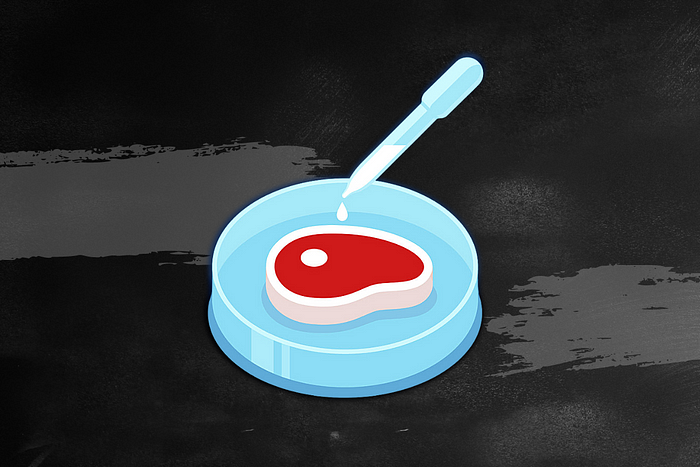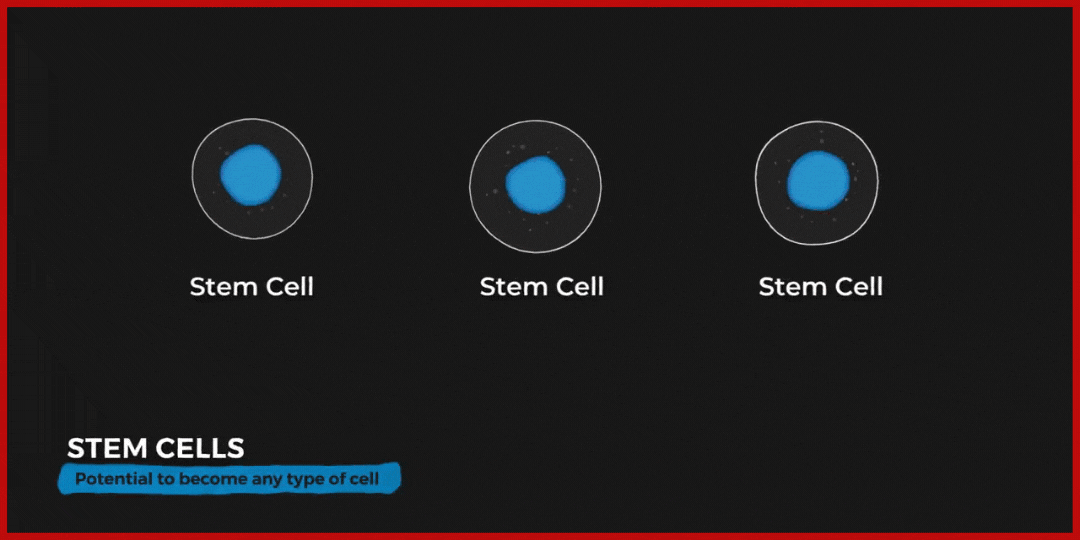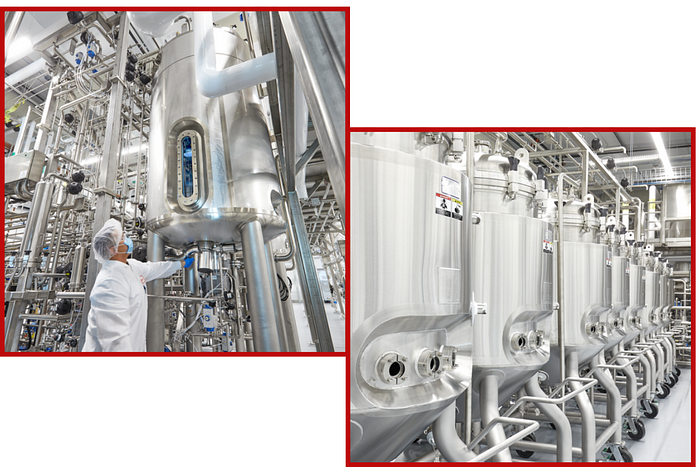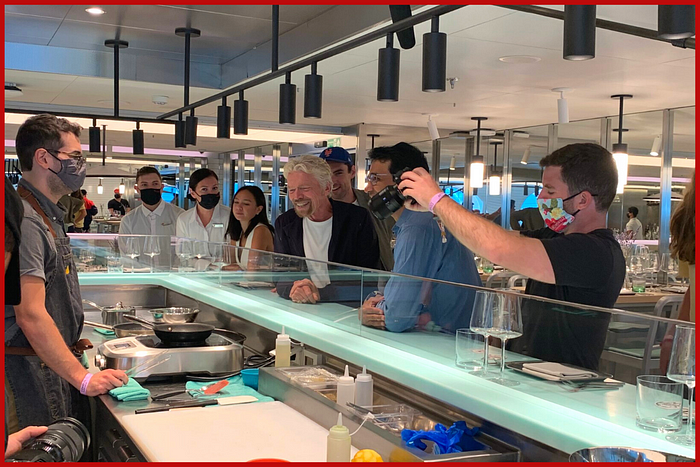

Lab-Grown Meat is Coming to Your Fridge This Year
source link: https://onezero.medium.com/lab-grown-meat-is-coming-to-your-fridge-this-year-cd0c4d57dee0
Go to the source link to view the article. You can view the picture content, updated content and better typesetting reading experience. If the link is broken, please click the button below to view the snapshot at that time.
Lab-Grown Meat is Coming to Your Fridge This Year
From grass-fed to electricity-fed

When our ancestors first started to eat meat two million years ago, they didn’t do it out of pleasure. Earth was too hot for vegetation to grow, leaving survivors with only one option: the rotten animal bodies they found lying across the savanna. It was ugly but necessary.
Then came fire, agriculture, and the industrial revolution, and our stinky savior turned into a silent killer. The more meat we produce, the more CO2 (and other nasty gases) we pump into the atmosphere, not to mention cardiovascular disease, antibiotic resistance and animal cruelty.
It’s no wonder reverting to a fully vegan diet became popular. On the surface, it sounds like a great solution, but if you dig deep enough, you’ll find three significant flaws.
- Our bodies evolved to demand nutrients that aren’t available in plants, and supplements can’t bridge the entire gap.
- Agriculture is a big source of greenhouse gases and deforestation.
- You can’t convince everyone.
These drawbacks have forced humanity to explore alternatives. One of them is cultivated meat, and it’s about to make its way into your fridge.
Wait, how do you even cultivate meat?
Instead of slaughtering an animal for steak, nuggets, or foie gras, the idea is to grow some inside a machine. The tech is called Cellular Agriculture, and its main ingredient is stem cells.
Why stem cells? They can transform into any type of cell. Picture Mystique from X-men: the shapeshifter who can perfectly mimic the appearance and voice of any person. Stem cells are the Mystiques of cellular biology, except for one difference. Once a stem cell transforms, it can’t revert to its original form. Instead, it becomes the new cell.

Stem cells are the raw material of manufactured meat, and different samples give you different products. For steak, you need cow cells; for nuggets, chicken cells, and so forth. To extract stem cells, veterinarians use biopsies, a process where you use a needle to remove about one gram of biological tissue from the host. Anesthesia suppresses pain, and animal donors can return to normal life within days.
Once you have your sample, it’s time to make it grow and multiply. For that, you need a Bioreactor. Bioreactors look a lot like high-tech beer breweries and have two functions. They protect your stem cells from external contamination and allow you to feed them so they can grow and multiply. The said food is a combination of amino acids, sugars, minerals, and vitamins, the same nutrients your favorite fitness influencer talks about.
Two or three weeks later, your cultivated meat will be ready for harvest. It won’t be a bunch of ready-to-cook steaks and nuggets, though. Instead, your stem cells will turn into a meaty mixture that requires extra conditioning to look, smell, and taste like the real thing — picture MasterChef but with high-tech gadgets. From there, it’s bon appétit. Or is it?
Is lab-grown meat bad for you?
The short answer is: it’s safe on paper, but we need more data to be sure. “The risk of foodborne illness from CBM [cultivated meat] could be theoretically non-existent,” Nature wrote. “The sterile conditions required for cell proliferation will prevent contamination with disease-causing pathogens.”

What about nutrition? Similar to plant-based alternatives, manufactured meat lacks certain ingredients found in nature like vitamin B12. There are two solutions we can explore here: add supplements or gene-editing. It’s likely we’ll use both, but the latter will be tricky to introduce because, let’s face it, Genetically Modified Cultured Meat doesn’t sound mouthwatering. But if we’re being pragmatic, gene-editing could be the holy grail of our food system. We could design our meat to be super nutritive, super tasty, and super healthy at the same time.
Now let’s look further than our bellies. In 2011, researchers compared the environmental impacts of the cultivated meat industry versus the animal-based one. They projected cultivated meat would:
- Consume 45% less energy.
- Emit 96% less greenhouse gas.
- Require 99% less land.
- Drain 96% less water.
These numbers derive from best-case scenarios that give skeptics solid reasons to question their validity. We need a real-life case study to settle the debate — and an ex-cardiologist named Uma Valeti is making it happen.
The UPSIDE of cultivated meat
In 2005, Valeti participated in a study that used human stem cells to repair deteriorated heart tissue. He figured we could use the same tech to cultivate animal tissue.
Fast forward to 2016, Valeti founded UPSIDE Foods (formerly Memphis Meats) and manufactured the first slaughter-free beef meatball in the world. Chicken, duck, and a lot of attention followed the breakthrough.
Renowned investors like Richard Branson, Bill Gates, and Suzy Welch backed the project. Even Tyson Foods, the world’s largest poultry producer, joined the party allowing UPSIDE to raise over $200 Million, enough to consider scaling up production.
In November 2021, UPSIDE Foods opened a meat cultivation plant outside Berkley, California. They called it the Engineering, Production & Innovation Center or EPIC.
“EPIC is UPSIDE’s first major production facility: 53,000 square feet of meat-making promise,” Valeti wrote. “[It’s] now capable of producing 50,000 pounds of finished product each year with an eventual annual capacity of over 400,000 pounds.”
Large-scale production isn’t the only priority on UPSIDE Foods’ menu, though. They also put a lot of attention on taste. The first thing you see when entering EPIC is a kitchen.

UPSIDE projects to ship the first cultivated chicken in 2022 and they know their journey will be no picnic.
Bloody debates around bloodless meat
First comes the labeling. What will we call this new kind of meat? It sounds dull, but labels are warzones in the food industry. Animal meat producers will push against cultivated by suggesting we should call it “Lab-Grown, Synthetic, or Cell-Based.”
Second is the FBS issue, which is short for Fetal Bovine Serum. It’s an essential ingredient for cultured meat, one that’s extracted from cow fetuses. When cows are going to slaughter and “happen to be pregnant,” their fetuses are artificially maintained alive. The goal is to drain as much fresh blood as possible before, you know, the source expires. Yes, that’s how we distill FBS.
Studies say that you need the blood of between 90 and 333 cow fetuses to create a burger. So much for “cruelty-free,” you might say. But hold that thought because we have alternatives.
Even better: In January 2022, Dutch startup Mosa Meat declared they found a way around FBS and made their solution open-source. True heroes. The alternative is 80% cheaper, which gives every meat cultivation company an economic incentive to adopt it.
“We’re committed to completely detaching our production process from animal slaughter,” UPSIDE Foods wrote. “We have already developed processes that do not require FBS and we are working to phase out the use of all animal components altogether.”
From grass-fed to electricity-fed
If manufactured meat keeps its momentum, we might no longer require to violate nature and torture innocent animals. We’d only need energy, which brings us back to the topic of sustainability.
Food production is responsible for a third of global emissions. If we manage to use green electricity to power our food system, we’ll drastically reduce emissions.
Like our ancestors who once turned to rotten meat out of necessity, we might want to use bioreactors to build a better future.
Recommend
About Joyk
Aggregate valuable and interesting links.
Joyk means Joy of geeK